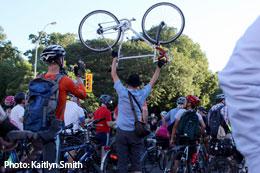Cycling plans exclude immigrant riders: study

By Kaitlyn Smith
New Canadian Media
Statistics on the true number of Canadians who ride bicycles are incomplete because they fail to capture cyclists who use them for other things than commuting to work, according to new research from the University of Waterloo.
In many of these cases, the cyclists are new Canadians, women and recreational users.
When urban planners and decision-makers design cycling infrastructure for a “bike to work” model, it is less safe for bike trips, such as for “leisure, visiting friends, shopping, school, bike deliveries, etc.,” researchers found.
In What Gets Counted Counts: Equity as a Lens to Rethink the Categorization of Cycling Trips, researchers Rebecca Mayers and Troy Daniel Glover advocate investing in data to understand how different demographics experience cycling in their communities.
Mayers says that an equitable approach to designing cycling spaces includes people who are traditionally excluded – which makes the space safer for everyone.
“People who have more need to shape [cycling] infrastructure, help make it safer for everyone who wants to participate,” Mayers told New Canadian Media in a telephone interview. “Privilege is seen through every facet of our societies — and transportation is not void of subjectivity.”
Sonam Vashisth, engagement coordinator with Toronto group Cycle TO, learned how to ride a bike in Canada when she was a 21-year-old international student at the University of Toronto. And even after three years on a bicycle, Vashisth says she is still learning.
“The sense of independence that comes with biking was very important to me,” Vashisth said.
A cousin tried to teach her how to ride on a suburban road in Thornhill, Ont. but he gave up in frustration and went inside after 30 minutes, she said. It took her five hours, but at 10 p.m. that day, Vashisth ran inside to celebrate cycling 20 metres without falling off.
Vashisth organizes workshops for Cycle TO to advocate for bicycling infrastructure, and lobbies community partners and leaders to focus on teaching others how to ride “whether it’s giving access to bikes or helmets, basic education workshops, or community rides,” she said.
Better cycling infrastructure advocacy is also about how you encourage people to get on their bikes, she added.
Recreational cycling was the most popular activity for Canadians in 2005, the most recent year Statistics Canada collected information on the use of bikes in the country.
Riding a bike for leisure also topped the list of bicycle use in a 2021 Canadian Community Health Survey.
In the article about their study, researchers at the University of Waterloo reported that complexities, particularly in women’s cycling behaviour, are much harder to capture. Low-income and racialized groups; delivery service workers; shift workers; those without stable housing; the elderly; and people with disabilities must also be considered.
“These cyclists are not invisible,” the article says. ”Their cycling behaviour does not always conform to the typical work trip.”









